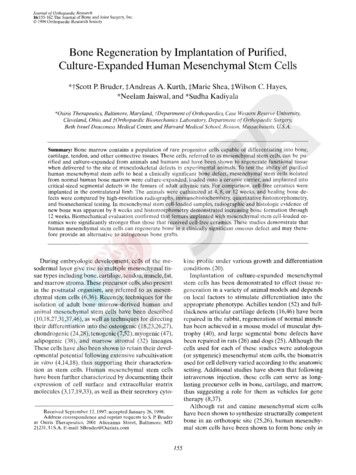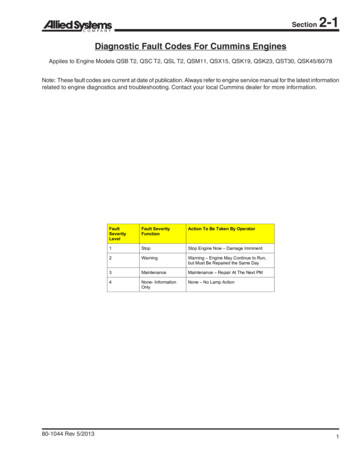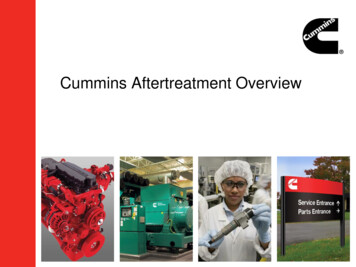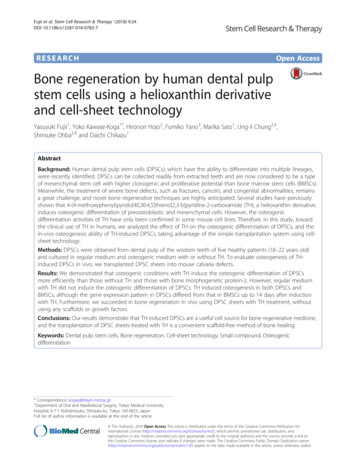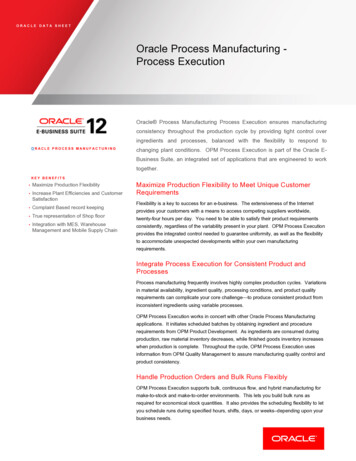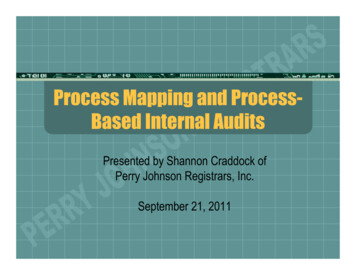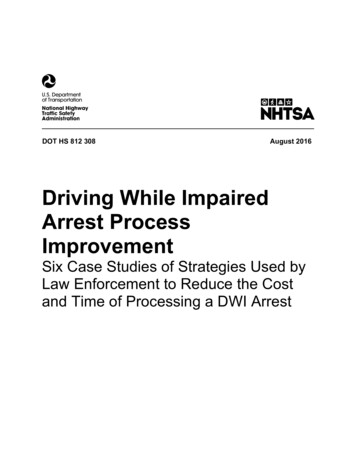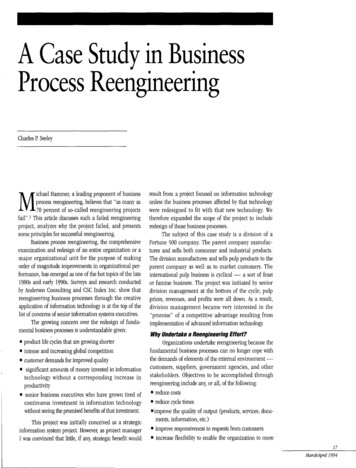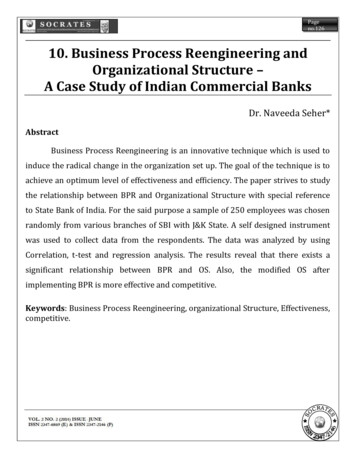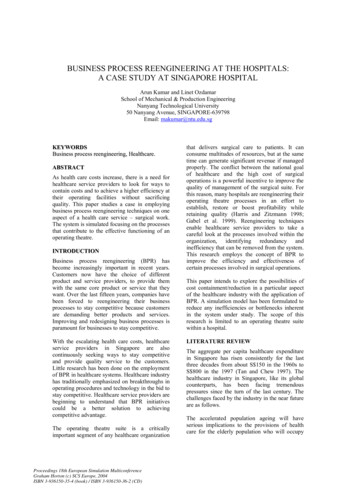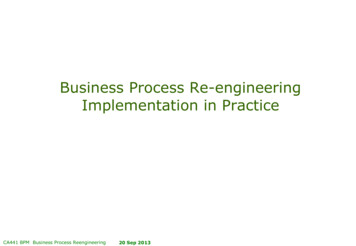
Transcription
Cummins ISXRegenerationProcess1
Introduction Cummins ISX––––EGR : Exhaust Gas RecirculationDPF : Diesel Particulate FilterVGT :Variable Geometry TurbochargerSCR : Selective Catalyst Reduction– 24V CONTROLS!2
Introduction The Cummins Particulate Filter consists of four sections:1. Inlet2. Diesel Oxidation Catalyst (DOC),3. Diesel Particulate Filter (DPF)4. Outlet Exhaust flows out of the engine and into the Cummins Particulate Filter.It passes through the DOC and then into the DPF where PM is collectedon the walls of the DPF. The PM collected is then oxidized to remove itfrom the DPF. This is known as regeneration. When operating conditions maintain sufficient exhaust temperatures, theDPF is continually self-regenerating. This is known as passive regenerationand results in clean exhaust out of the tailpipe. On very infrequentoccasions, an active self-regenerationis required to remove a build-up ofPM in the DPF, due toinsufficient exhaust temperatures.3
EGR The EGR cooler (1) cools the exhaust gases flowing to the EGR valve. TheEGR cooler is mounted above the exhaust manifold and is supported bythe EGR valve mounting bracket attached to the rocker housing. Because the EGR valve (2) is mounted after the EGR cooler, the EGR cooleris subject to the same exhaust temperatures and pressures as the exhaustmanifold. The EGR cooler has a coolant vent (3) near the exhaust inlet of the EGRcooler. This vent prevents air from being trapped in the cooler duringcoolant filling and engineoperation by continuouslyflowing coolant to the toptank of the vehicle coolingsystem.4
ISX Exhaust pressure in the exhaust manifold (which determines theposition of the VGT and the EGR valve) is measured by an exhaustpressure sensor. To maximize the durability of the exhaust pressure sensor, the sensordoes not mount directly into the exhaust manifold. The exhaustpressure sensor is connected by a tube to the exhaust manifold. The exhaust pressure sensor is located on the EGR cooler coolantoutlet connection for additional cooling of the sensor.5
DPF The aftertreatment Diesel Particulate Filter (DPF) system is used toreduce particulate emissions and is composed of six main components:1. Aftertreatment inlet and aftertreatment Diesel Oxidation Catalyst(DOC)2. Aftertreatment DPF (Differential Pressure Sensor)3. Aftertreatment DPF4. Aftertreatment outlet5. Aftertreatment exhaust gas temperature sensors6. Aftertreatment DPF temperature sensor interface module6
ISX Passive regeneration occurs when the exhaust temperatures arenaturally high enough to oxidize the soot collected in theaftertreatment DPF (1) faster than the soot is collected. Passive regeneration typically occurs when the temperature of theaftertreatment DPF is above 316 C [601 F]. This occurs duringhighway driving or driving with heavy loads. Since passive regeneration occurs naturally, it is considered to benormal engine operation. No fuel is added to the exhaust streamduring passive regeneration.7
ISX Active Regeneration occurs when the exhaust temperaturesare not naturally high enough to oxidize the soot collected in theaftertreatment DPF faster than it is collected. Active regeneration requires assistance from the engine in order toincrease the exhaust temperature. This is typically done by injectinga small amount of diesel fuel into the exhaust stream (calledaftertreatment injection) which is then oxidized by theaftertreatment DOC. The oxidation of this additional fuel createsthe heat needed to regenerate the aftertreatment DPF. For active regeneration to occur, the engine control module(ECM) MUST detect that the aftertreatment DPF restriction hasreached a specified limit. Once this limit is reached, the engine willalter its operation in order to create exhaust temperatures highenough to actively regenerate the aftertreatment DPF.8
Passive Regeneration Cummins engines are designed to maximize the use of passiveself-regeneration. This occurs when operating conditionsmaintain sufficient exhaust temperature, therefore enablingcontinuous oxidation of the PM. Passive self-regeneration iscompletely transparent to the operator and does not affectthe operation or performance.9
Stationary Regeneration Stationary, or parked regeneration is the same as activeregeneration but takes place while the equipment is not beingoperated. It offers the equipment operator the option, ifneeded, of performing regeneration outside the normal dutycycle. Using this option may only be required in a very limitednumber of applications.10
DPF Symbols DEF Lamp High Exhaust Temperature DPF Regeneration Required MIL Lamp DEF Level11
Malfunction Indicator Lamp (MIL)(Illuminated) Used on engines that are equipped with On-boardDiagnostics (OBD), the emission control system monitorsand reports malfunctions that impact the emission controldevices. If the OBD detects such a malfunction, the on-boarddiagnostic system illuminates the MIL to indicate that theengine needs to be serviced at the first availableopportunity. The MIL can be illuminated along with any of the engineindicator lamps.12
High Exhaust System Temperature (HEST) Lamp The HEST Lamp illuminates to indicate that high exhausttemperatures may exist due to after-treatmentregeneration. This is normal and does not signify the need for any kind ofvehicle or engine service. When this lamp is illuminated, ensure that the exhaustpipe outlet is not directed at any combustible surface ormaterial.13
After treatment Diesel Particulate Filter(DPF) LampThe After treatment DPF Lamp indicates, when illuminated orflashing, that the after treatment DPF requires regeneration. This isaccomplished by the following:1.The Van Hool coach is equipped with a Regeneration InhibitSwitch; ensure that the switch is not in the Inhibit position.2.Perform DPF regeneration by one of the following methods:a. Change to a more challenging duty cycle, such as highwaydriving, for at least 20 minutes.-- OR –b. Perform a parked regeneration.14
DEF LampIlluminated An illuminated DEF is an indication that the DEF level is low(15% remaining). This can be corrected by refilling the DEFtank.15
DEF LampFlashingA flashing DEF lamp indicates that the DEF level has fallen belowa critical level (10% remaining).This can be corrected by refilling the DEF tank.Note: Van Hool recommends that the DEF level not fall below20%. Allowing this can cause fault codes.16
DEF LampFlashing with Check Engine Light A flashing DEF Lamp combined with an illuminated MIL Lampindicates that the DEF level is critically low (5%). A speed inducement of 55 mph will be enacted the first timethe ignition switch is cycled off then back on. The speed limit of 55 mph will be suspended during pumpingoperations. Normal engine power and vehicle speed will be restored afterthe DEF tank is refilled.17
DEF LampStop Engine Lamp, MIL Lamp with flashing DEF If the engine has been shut down after the DEF tank has run dry,the Stop Engine lamp will also be illuminated, along with theflashing DEF Lamp. A speed inducement of 25 mph will be enacted the first timethe ignition switch is cycled off then back on. The speed limit of 25 mph will be suspended during pumpingoperations. Normal engine power and vehicle speed will be restored afterthe DEF tank is refilled.18
After Treatment Diesel ParticulateFilter (DPF) LampFlashing If regeneration is not performed in a timely manner afterthe DPF Lamp is illuminated, the DPF Lamp will begin toflash. This indicates a higher level of soot in the DPF.a. Change to a more challenging duty cycle, such ashighway driving, for at least 20 minutes.ORb. Perform a parked regeneration.19
Regeneration Process OverviewA message that may appear on dashboard displayDPF REGENERATION REQUIREDTwo options to perform regeneration:1. Automatic Regeneration: Drive at highway speeds forminimum of 20 minutes without dropping speed below5MPH.2. Stationary Regeneration: Involves the following procedure:Note: DPF lamp must be solid or flashing to perform stationaryregeneration.20
Regeneration Process OverviewLocation of Regeneration buttons in engine compartment:Force RegenerationRegeneration Inhibit21
Regeneration Process Cummins EngineEquipment Conditions:1. Engine running Temperature range of 175 to 185 Fahrenheit.2. Parking brake on (Wheels chocked).3. Transmission in Neutral.4. HVAC System off.22
Regeneration Process Cummins Engine Press “Force regeneration switch” for at least 2-7 seconds. If Regeneration is accepted, RPM will rise until regenerationis complete.Note: Prior 2009 models had regeneration switch inside the cab in driver controls.23
Regeneration Process OverviewRegeneration in process: Once regeneration process has begun, engine RPM’s increaseto 1500. Observe vehicle and immediate surroundings duringregeneration. Regeneration process takes 20 to 40 minutes. When regeneration has been successful, the engine speedautomatically returns to idling speed, and the “DPFRegeneration” symbol will turn off. If the “DPF Regeneration” symbol reappears, the regenerationprocess has failed. In that case, ask for technical assistance.24
Regeneration Process OverviewTo Interrupt Regeneration:WARNING! If an unsafe situation occurs, stop theregeneration process immediately by pushing the brakepedal or by switching off the engine. The regenerationprocess is also stopped if you momentarily press the“Regeneration Inhibit” button.25
For questions regarding this webcastplease contactABC’s Technical Service Departmentat 877.427.7278.Listen for the prompts for Coach Technical Support, and select theappropriate option. Support is available at this number 24/7.26
ISX Active Regeneration occurs when the exhaust temperatures are not naturally high enough to oxidize the soot collected in the aftertreatment DPF faster than it is collected. Active regeneration requires assistance from the engine in order to increase the exhaust
